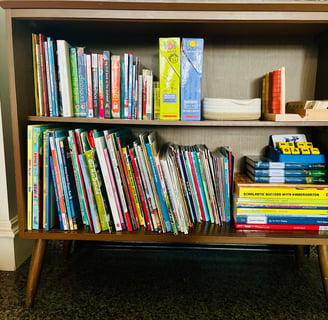Creating a Book-Loving Home: Tips for Raising Readers
FAMILY FUN AND CONNECTION
Monica Rene
2/13/20254 min read


It’s easy to overlook something as simple as having books in our homes. Whether it’s a picture book for the kids or a novel for yourself, books are one of the most powerful tools we have for learning, growth, and connection. Instead of worrying about clutter, I encourage you to embrace books in all their forms and let them be an integral part of your family’s everyday life.
Why Having Books in the Home Matters
Books aren’t just for reading. They’re powerful tools that stimulate imagination, provide education, and nurture relationships. Having books available in every room of the house encourages learning and invites curiosity.
For children, having access to books throughout the home is especially important. Books provide a gateway to creativity, critical thinking, and emotional intelligence. They’re a chance for kids to explore new worlds, understand different perspectives, and develop a lifelong love of learning. Books also foster language development, helping children to expand their vocabulary, improve reading comprehension, and stimulate cognitive growth.
As parents, books are an opportunity for you to bond with your kids, especially during bedtime stories or quiet moments. But beyond that, books can serve as valuable resources for you too. Whether it’s a self-help book, a biography, or a novel, having books within arm’s reach allows you to prioritize your own personal growth while setting a strong example for your kids.
Where to Place Books in Your Home
Think about how much easier it is to read when books are right there when you need them! It’s not about keeping books in one designated area like a bookshelf in the living room—spread the books around so that they’re easy to access no matter where you are.
In the Living Room – Keep a basket or a shelf with children's picture books, novels, coffee table books, etc in your living room. Make them easily accessible so your family members can grab them when they need a moment of calm or a fun read.
In the Kitchen – Yes, books can live in the kitchen too! Kids books, physical cookbooks, or some wellness books might be a great addition to your kitchen space. It can provide inspiration for meal planning, or even just give you something to enjoy while you're waiting for your tea to steep.
In the Bedrooms – Place a basket of books or a shelf in your child’s room or even on your bedside table. For the little ones, bedtime stories are essential, and for adults, it’s important to cultivate your own reading habits. A few calming books can help wind down at the end of a busy day.
In the Car – Keep a stash of books in the car for road trips, waiting in line, or when you’re out running errands. A few books on hand can make the time spent in the car more enjoyable for both adults and children.
In the Bathroom – While it might seem like an odd place for books, having a magazine or light reading material in the bathroom can offer a moment of peace and help reduce the rush that often comes with daily routines.
Create a Library Space – If you have room, create a cozy nook or corner where your children can sit, read, and immerse themselves in their favorite stories. This can help foster a love for books and give your child a place to retreat into their own imagination.
Why the More, the Merrier
The more books you have, the more exposure your kids will get to different stories, vocabulary, and ideas. Don’t be afraid to collect a variety of books—board books, picture books, chapter books, nonfiction, and everything in between! Each book brings something unique to the table, and the more varied your collection is, the more well-rounded your child’s experience with reading will be.
Some parents might worry about their books becoming clutter, but the reality is that books are far from clutter. They’re an investment in your child’s intellectual and emotional development. With a little creativity, you can keep your books organized and accessible without overwhelming your space. Use baskets, shelves, or decorative containers to store and display books in every room, so they remain part of the everyday flow of life.
Embracing Books as Part of Your Family’s Routine
Books have become a fundamental part of our home and our daily routine. My kids love having books in every room. It encourages them to pick up a book on their own when they have a moment, rather than gravitating toward a screen. It also gives us so many opportunities for shared experiences, whether it’s reading together before bed or discovering a uniquely illustrated book they can dive into on their own.
The books in our house are not just for the kids. I make it a point to read for my own personal development, and I try to model this for our little ones. I used to think that if a book wasn't related to something educational or medical, it was a waste of time. Now, I've realized how much reading a physical book helps me relax and unwind. It’s all about showing my kids that reading is something to value and enjoy—not just an activity for school, but a lifelong source of enrichment.
Final Thoughts
Instead of thinking of books as clutter or taking up too much space, reframe your thinking. Books are invaluable treasures that provide knowledge, imagination, and relaxation. By incorporating them into various corners of your home, you’ll inspire your children to read, explore, and dream. And the best part? You’ll be fostering a love of reading that will last a lifetime.
